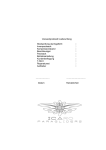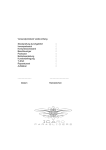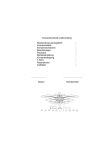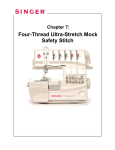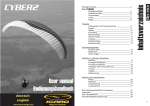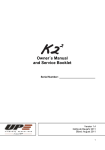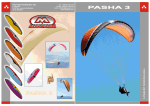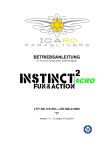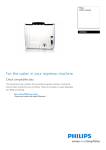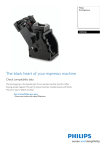Download incanto - 1.00 - e
Transcript
INCANTO - 1.00 E Date 10/08/06 wings for dreams INCANTO User Manual www.icaro-wings.de wings for dreams Page 1 / 34 INCANTO - 1.00 E Date 10/08/06 wings for dreams Page 2 / 34 I. Important Limitations Infos _____________________________________________________3-4 II. INCANTO Design Design Brief _______________________________________________ 5 Technical specifications______________________________________ 5 Speedindikator_____________________________________________ 6 Lines _____________________________________________________ 7 Canopy___________________________________________________ 7 III. Using your INCANTO Ground handling____________________________________________ 8 Pre-flight checks____________________________________________ 9 Launch Preparation _________________________________________ 9 Launch___________________________________________________10 Turning and thermaling ______________________________________10 Accelerating ______________________________________________11 Active Flying ______________________________________________ 11 Landing______ ____________________________________________11 Towing __________________________________________________12 IV. Descent techniques Small and Big ears________________________________________ 12 B-line-stall _______________________________________________13 Spiral dive _______________________________________________14 V. Flight incidents Deep/parachutal stall _______________________________________15 Asymmetric collapse _______________________________________15 Symmetric collapse ________________________________________16 Cravat ___________________________________________________16 Negativ spin ______________________________________________17 Full stall _________________________________________________17 Emergency streering _______________________________________18 VI. Maintenance Repair and Inspection Maintenance ______________________________________________18 Repair __________________________________________________ 19 Inspection ___ ____________________________________________ 19 2-Annual check ____________________________________________20 DHV - Certification __ ___________________________________________24 DHV – Luftsportgeräte – Kennblatt with Line Plans_____________________25 Team ICARO __________________________________________________ 33 Warrenty-Map __________________________________________________34 INCANTO - 1.00 E Date 10/08/06 wings for dreams Page 3 / 34 I. IMPORTANT LIMITATIONS FOR USING ICARO PARAGLIDING EQUIPMENT Flying sports are potentially dangerous and can cause serious injury or death. The owner is responsable for all risks associated with the use of the paraglider. This paraglider has been certified and built in compliance with DHV 1-2 rules and regulations. Do not change your gliders configuration. If you do, your glider will loose DHV 1-2 certification. Before every launch, please conduct a detailed pre-flight inspection to ensure your glider and equipment is in safe operating condition. Although flying the INCANTO is exhilarating, every pilot should always respect the rules of flying together with other pilots. Otherwise, flying may become highly dangerous and can cause serious harm. Only if we respect each other and understand that every pilot has personal ambitions, we can fly in harmony and securely enjoy these wonderful sensations. INCANTO DHV 1-2. Icaro Paragliders Hochriesstraße 1 83126 Flintsbach, Germany Ph. +49-(0) 8034-909 700 Fax +49-(0) 8034-909 701 E-mail: [email protected] WEB: http://www.icaro-wings.dem INCANTO - 1.00 E Date 10/08/06 wings for dreams Page 4 / 34 To familiarize yourself with your glider, please read this manual carefully. By doing this, you will be better prepared to deal with any critical flight incidents which may occur. This manual contains important design information about your glider, flight characteristics and technical specifications. Maintaining your INCANTO is also part of this manual to ensure you have the right knowledge to always keep your glider in good shape. If you sell your glider please transfer this manual to its new owner. It is strictly prohibited to fly this glider Outside the DHV specified weight range. With insufficient training and experience. This glider is recommended for advanced to expert pilots only. This requires training and obtaining a pilots licence in accordance with your local practices and laws. Without doing inspection. a detailed systematic pre-flight If you are not sure of the weather conditions, equipment status or personal mental/physical health. Inducing roll angles exceeding 45°. Aerobatics prohibited. are highly dangerous and therefore Using an engine if the glider is not certified for motorized flight by DULV. In adverse weather conditions including: high wind, turbulence, rain, snow, hail, lightning, fog or inside of clouds. INCANTO - 1.00 E Page Date 10/08/06 wings for dreams 5 / 34 II. INCANTO Design The design brief for the INCANTO was to create a glider within the safety of the DHV 1-2 class that would compete with higher class gliders in terms of glide, sink rate, speed and handling. We designed it to meet the highest expectations of experienced fun class pilots who fly regularly and want performance and direct handling, without leaving the safety of the DHV 1-2 class. Handling of the INCANTO is direct, responsive and well balanced. . Technical Specifications: INCANTO Größe XS S M L Flat surface area Projected area Flat surface span Aspect ratio No. Cells Take off Weight V trim V max No. Risers Weight Certification m2 m2 m A/R 21,87 18,95 11,12 5,65 55 55-75 38 < 50 4+1 24,37 21,11 11,73 5,65 55 65-90 38 < 50 4+1 6,0 DHV 1-2 27,00 23,39 12,35 5,65 55 80-105 38 < 50 4+1 6,2 DHV 1-2 30,34 26,28 13,09 5,65 55 100-125 38 <50 4+1 6,4 DHV 1-2 kg km/h km/h kg DHV BEP Standard colour scheme of INCANTO is white/black/red - white/black/blue – white/black/sunflower.. Other colours are available via special order. INCANTO - 1.00 E wings for dreams Date 10/08/06 Page 6 / 34 Our test team conducted many hours of flying prototypes designed by Michael Nesler's Fly CAD FD Paraglider Design Software to create a glider consistent with the legacy of ICARO´s famous laminar hang gliders. Our main design goal was to develop sophisticated wing profiles that result in maximum performance combined with safety. These profiles were calculated and designed one by one. In combination with an optimised leading edge, we created a Paraglider with high potential. The leading edge is reinforced with Mylar inserts which results in easier inflations, and more performance and stability while flying accelerated. The use of extensive internal v-ribs makes the canopy more stable, especially in turbulence, and maintains a cleaner, more tensioned, wing profile. This also causes the loads to be distributed more uniformly throughout the glider, allowing for an increase in aspect ratio while simultaneously reducing the number of line attachment points. The exceptionally high flat and projected aspect ratio is key to the INCANTO`S cutting edge performance. As a result of optimal use of v-ribs, the canopy is only connected to lines at every third cell. Further, the line plan of the INCANTO is reduced to just two line levels. Less lines lead to less drag and an increase in glide performance. Brake lines are attached to each cell of the canopy. Combined with many hours or refining and trim work by our test pilots, we have achieved very desirable handling. The brake configuration also makes the INCANTO special in extreme situations and extreme turns, easier to control and provides great feedback to the pilot. Pilot input is direct and responsive. The brake handles contain a removable reinforcement made of fibreglass. The risers of the INCANTO are designed for easy use in 4+1 style. This ensures pilots always have a familiar riser configuration and easy access to the big ears manoeuvre. Speedindikator (BEST GLIDE) The INCANTO has a lift/drag ratio in the trim flight, which corresponds to the current state of the art. The harness has a mark that indicates 2/3s of the total speedway. At this point you should be in best glide. INCANTO - 1.00 E wings for dreams Date 10/08/06 Page 7 / 34 Lines: To ensure durability, ICARO uses Edelrids HMA lines for the INCANTO. These lines won't stretch and transfer pilots handling directly to the canopy. Depending on the line level, we use different diameters: - Diameter 1,8 mm - breaking strength 229 daN - Diameter 1,1 mm - breaking strength 114 daN. Canopy (sailcloth): Porcher Marine New Skytex NCV 9017 E 77 polyurethane-coated rip stop nylon. Selected for its durability and resistance to UV-damage. New Skytex has become the reference standard used by the majority of high quality paragliding manufacturers. INCANTO - 1.00 E wings for dreams Date 10/08/06 Page 8 / 34 DHV Certification: Following our philosophy to only build gliders with the highest safety, we design our gliders to meet DHV strict and robust regulations. DHV is the most respected worldwide certification agency and provides standards for the classification of gliders with specific in-flight behaviours. This allows pilots to find optimum gliders commensurate with their level of training, experience and skill. INCANTO 1-2 certification is valid using any harness which is categorized "GH". The vast majority of harnesses produced after 1993 will be category "GH". "GX" and other special single purpose harnesses are not recommended because of the cross-braced strapping which detracts from the ability to steer by weight shifting. These harnesses were once popular due to isolating the pilot from feeling turbulence, but it has long since been discovered that feeling the gliders reaction in turbulence is important for pilot awareness and the ability to provide corrective input. To find out which class of harness your harness belongs to, check the certification sticker or ask its manufacturer. III. Using your INCANTO: Ground Handling: We highly recommend several hours of ground handling with the INCANTO to thoroughly familiarize yourself with its launch behaviour, prior to your first mountain flights. Ground handling is the best way to improve your safety in this sport. If you practice two hours on the ground for every hour on the mountain, you will quickly become masterful at launching in a variety of wind strengths and conditions. Ground handling or "kiting" can become great fun as a sport on its own, and will improve your overall enjoyment of flying by making your launches easier. You will become more skilled, confident and relaxed and therefore be able to enjoy more controlled launches and the sensations of flight without fear. It will also teach you arms muscle-motor-memory skills to react and absorb turbulence. This keeps the glider flying over your head and maintains pressure in the sail, preventing collapses in-flight. Always anticipate the possibility of becoming inadvertently airborne, so make sure to wear a helmet and gloves. Be cautious in strong winds exceeding 20 km/hr as the possibility of getting lifted or dragged increases. INCANTO - 1.00 E wings for dreams Date 10/08/06 Page 9 / 34 Pre-Flight Checks: It is important to perform a pre-flight check before taking off. Doing this which a set methodology is helpful: Canopy. It is most efficient to check while unfolding your glider. Do not rely on others. Always take into consideration that your INCANTO may have been damaged during transportation. The sailcloth, stitching and line attachment points must be carefully inspected. Pay attention especially to the leading edge and sight into the glider to inspect internal rib structure. Lines. Look for knots and damage. Lines may have a broken outer sheath, kinked or broken HMA inside. Stitching at looped ends may be frayed or broken. Brake lines should be symmetric. Risers. Start with the stainless steel karabiners. Make sure they are all at least finger tight. Check all plastic retainers are preventing lines from cross-gating the karabiners. Check for stitching and fraying of risers. Check the speed system by pulling and activating it. Harness. Inspect all stitching and webbing. Check the reserve parachute pin and handle location and release handle from Velcro and rescue. Harness Buckles. Make sure you are clipped in: both legs and chest. Harness-Glider Carabiners. Actuate the carabiners and ensure they latch securely and can not be opened accidentally in flight. Risers need to be untwisted with the A-Risers facing forward as in-flight. Speed System. Make sure Brummel hooks connect the foot pedal to the risers, with at least 3 cm of slack, so that the glider is not accidentally accelerated during launch. Do this by pulling on the speed pedal and checking for free travel. Launch Preparation: Before laying out your glider, carefully study the wind direction, speed and gustiness at launch. Never launch in stronger conditions that you have routinely practised on your training hill. Study the terrain in detail and select a spot that will: insure you are precisely aligned into the wind; maximize your takeoff run-way; maximize your distance from trees and obstructions; minimize being in a wind shadow or turbulence from launch terrain. Then expand your attention to a wider INCANTO - 1.00 E wings for dreams Date 10/08/06 Page 10 / 34 area to ensure you are not in the lee-side of prevailing winds and that there is no high instability cumulus clouds or gust fronts approaching. Lay out your INCANTO on its top surface in a pronounced arc, with the centre of the wing higher on the slope then the tips. This ensures the centre of the glider will inflate first and the glider will have less tendency to turn. Make sure the entire leading edge inlets are pointing upwards, towards the sky, and under span-wise tension to ensure they will take air in easily. The closer the laid out glider resembles its in-flight appearance, the easier and more quickly it will inflate. Lay out the lines one half of the glider at a time. Hold up one riser set and start at the bottom first with the brake lines, pull all lines clear. Repeat with the D, C, B and conclude by separating the A lines. Lay checked lines on top of the previous set and make sure that no lines are tangled, knotted, or snagged. Mirror the process on the other side. Launch: After conducting the pre-flight checks and launch lay out as described above, recheck immediately before take off: wind direction and strength has not changed airspace in front of launch is clear of all other gliders and visibility is clear The INCANTO is designed having classic ICARO superb take-off characteristics. ICARO gliders have split A-risers. For reverse launching in stronger winds, just use inner A-Risers. In nil and light wind your INCANTO will launch effortless by using progressive pressure on all the A-risers until the wing is fully overhead. When doing forward launch do not forget to do a shoulder check, looking up briefly while keeping your body weight forward and down, to check the canopy is perfectly inflated above you without line tangles or debris in the lines. Never take off with a glider that is not fully inflated. Turning and thermaling: Your INCANTO is very agile and reacts precisely to the smallest steering impulse. To make efficient and co-ordinated turns with your glider: use weight shifting and smooth application of the brakes. The more you use your inner brake, the faster the glider will turn. Use outer brake for adjusting speed, radius and bank angle of the turn. Do not use inner brake excessively; otherwise it will result in a spiral dive. Do not use both brakes beyond a certain point. This can cause a symmetric stall or spin. INCANTO - 1.00 E wings for dreams Date 10/08/06 Page 11 / 34 Accelerating: For better penetration in headwinds you can fly faster by using the accelerator system. Using the accelerator decreases the angle of attack and can make the glider more prone to collapse. Therefore excessive use of the accelerator near the ground should be avoided. Before using this system it should be well adjusted. Make sure it is attached properly. Speedsystem and harness are to be adjusted to each other in order to get the best performance. Do not use the acceleration system and brakes at the same time! It is very dangerous to use them both simultaneously while flying your INCANTO and can result in serious collapses. Active Flying All good pilots react to the feedback their gliders send them, and are constantly adjusting their speed, pitch and roll to match its movements in the air. As the glider pitches in front of them they use the brakes to slow it down. Similarly, as the glider drops behind them, they release the brakes to speed it up. These movements can be symmetric or asymmetric: so they may be applying both brakes or one. They may also roll their bodies with weight shift to move with the glider when the glider rolls to the right or left. These subtle adjustments keep their gliders flying smoothly and directly above them. These are skills that can also be learned from the safety of practicing ground handling on small grass hills or even flat fields, using a steady wind, while kiting the paraglider overhead. Landing The INCANTO is very easy to land. Make sure you choose a big and safe landing area. Straiten up in your harness some 50 meters before touching the ground and prepare landing. Before hitting the ground reduce speed by appling brakes smooth and forcefull to full arm extension below the seat of the harness. Towing: INCANTO - 1.00 E wings for dreams Date 10/08/06 Page 12 / 34 Your INCANTO is also designed to permit winch towing. Be aware however, that getting towed is more complex than foot launching, because there is additional equipment and a towing operator, all of which must be perfectly coordinated to work together. When getting towed always be sure that you perform a pre-flight check of your equipment. Then make sure you do a pre-flight check of all the tow system winch components, your tow bridal release system and signals to communicate between pilot and tow operator. Before increasing the tow-line tension for takeoff, check that the wing is properly inflated and directly overhead. After that, give your supervisor the okay sign. While getting towed, it is important that the towing force does not exceed 100 kp. Generally the towing force should equal the weight of the towed pilot. It is very dangerous to tow pilots who do not have a towing-licence or without instructor supervision. Also every component of the towing equipment (harness, winch and release bridals) should have certification that declares conformity for towing. Also be sure that you work with an experienced team that you trust. IV.Descent techniques Fast descents may be appropriate in certain flight situations. Some examples of when quick descent may improve safety: to descend away from a cumulus cloud that is generating too much lift; to land before a storm arrives; to avoid landing in a small or restrictive area. Your INCANTO is capable of several descent techniques. These techniques should be practiced the first time under the supervision of an instructor. We recommend the following manoeuvres, in order of increasing descent rate potential : Small and Big Ears Small Ears is folding-in the wing tips of your INCANTO to increase the sink rate. To do so, use only the outer A-risers and pull them down. After initiating the small ears, you may also step into your speed system and push it so that the pitch angle of your glider is compensated and your speed and sink rate further increases. This technique results in descents rates of up to -3.0 m/s. Doing Big ears is only recommended in emergency situations when in need of higher descent rates for example: descending through strong thermals which would otherwise pull you into cumulus clouds or approaching storms. To do big ears: sit upright and take only the outer 2 A-lines one each side of the glider (not the entire A-risers). Pull them slow and in one smooth motion, so that nearly 25% of the wing is collapsed on each side. Note that once big ears are in, you have less wing area supporting you and your stall speed will have increased. Do not use brakes other than for re-inflation. For directional control while using the big ears, you should use weight shift. After initiating the big ears, you may also step into INCANTO - 1.00 E wings for dreams Date 10/08/06 Page 13 / 34 your speed system and push it so that pitch angle of your glider is compensated and your speed and sink rate further increases. This descent technique results in descent rates of up to -4.5 m/s. To re-open the wing tips, smoothly release the speed system and then the lines. Normally wing tips will re-inflate automatically. You can help the process by leaning away from the side you want to re-inflate and gently pumping the brakes. Do this one side at the time to minimize the chance of inducing a stall. Warning: Do not use small or big ears near the ground! B-line stall Before initiating a b-line stall, the pilot should check sufficient terrain clearance to fully perform and exit the manoeuvre. It is also imperative the pilot fully commits to completing the manoeuvre, as a premature release while the glider is still falling back and not fully stalled may lead to a large diving surge and possibility of pilot entanglement with the glider. Descent rates exceeding -8 m/s can readily be achieved. B-stall is performed by symmetrically pulling down on the B-Risers. It takes a lot of force to B-line the INCANTO but after a certain point it will stall smoothly and start gaining descent speed. Forward speed will reduce to a minimum. To initiate a B-line stall: do not release brake handles. Firmly grasp the steel karabiners on each B-riser. Make a deliberate, forceful, sharp pull downward until your elbows touch your chest (similar to doing a chin-up) and hold in that position. Do not release either side: the glider will crease along the b-line level; slow and stall; fallen slightly behind the pilot will swing back under the canopy; and finally, the canopy will stabilize overhead in a stable b-line stall. Only when in a stable bline stall the manoeuvre can be released. To exit the B-line stall: the B-risers should be released symmetrically and in one smooth, progressive motion. The glider should resume normal forward flight without further input. Check you have forward flight again before using brakes. If forward flight has not resumed, push gently forward with open palms on each A-riser: the glider will leave parachutal stall and resume normal flight. Attention: It is very dangerous to enter or exit a B-line stall incorrectly. The following pilot errors must be avoided: Pulling B-Risers insufficiently or asymmetrically: may result in deep stall or spin. Premature release of B-Risers as glider is falling back just starting to stall: may result in big diving surge. INCANTO - 1.00 E wings for dreams Date 10/08/06 Page 14 / 34 Pulling B-lines too far so that A-risers are pulled too: may result in rosette or front horseshoe. Pulling C-risers instead of B: may result in full stall. Slow releasing of B-risers: may result in deep stall. Asymmetric release of B-Risers: may result in spin. Releasing risers without releasing brakes as well: may result in deep stall. Using brakes directly after exiting: may result in deep or full stall. Spiral dive This manoeuvre can result in extreme descent rates and very high vertical and rotational speeds. Spiral dives with sink rates over 8 m/s are possible but not recommended. They are dangerous and put unnecessary strain on the glider. If a pilot looses control while spiral diving, speed can quickly build up to -20 m/s. This results in high G-forces on the pilot that can be affecting and disorienting. Pilots conducting spiral dives should have collected enough experience to be mentally and physically prepared for the extreme forces of this manoeuvre. Spiral dives need time and height to recover. Do not perform this manoeuvre near the ground. If you turn your INCANTO in a series of tight 360s it will enter a spiral dive. This will result in rapid height loss. To initiate a spiral, look in the direction you want to go, roll your body weight in that direction, and then smoothly pull down on the inside brake. Your INCANTO will first turn almost 360 degrees before it drops in to the spiral. Once in the spiral you must apply a little outside brake to keep the outer wing tip pressurized and inflated. Safe descent rates of 8 m/s (500 ft/m) are possible in a spiral dive, but the high speeds and G-force can be disorientating, so pay particular attention on altitude and surrounding airspace. While performing a spiral dive you can adjust sink rate with your outer brake. If you do not use outside brake and continue to add inside brake while allowing your body weight to roll inside, the spiral will rapidly accelerate and it will become more difficult to regain control and exit. To exit the spiral dive: slowly release the inside brake; bring your body weight to the outside of the spiral; and apply a small amount of outside brake. As the INCANTO - 1.00 E wings for dreams Date 10/08/06 Page 15 / 34 INCANTO decelerates you allow it to continue to turn until enough energy is lost for its return to a level flight without an excessive climb and surge. V. Flight Incidents Warning: simulation of flight incidents (SFI) should only take place at professional safety training seminars with professional trainer and only while flying over water. For your safety, SFI training should only be conducted in a very carefully controlled environment: rescue boat in position, life jacket, well adjusted radio and reserve parachute. Always listen to your trainers instructions. Deep/Parachutal Stall Your INCANTO has been carefully designed to resist entering deep stall. To practice a deep stall during SFI training involves flying very slowly, near ¾ of full brake extension and then modulating the brakes, not quite fully stalling the glider so that it does not fall back, but stays overhead. Because it is very difficult to achieve on modern gliders, and can lead to severe complications, it is often omitted from modern safety training. A deep or parachutal stall occurs when a paraglider has its usual shape, but is descending vertically without moving forward. In most situations the INCANTO will exit deep stall and resume normal flight almost instantly. In the unusual circumstance that deep stall occurs, reach up and push forward with open palms on both A-risers until normal flight returns. Once in normal forward flight, it is safe to use brakes again. Asymmetric Collapse While flying in turbulent conditions it may occur that a portion of your glider deflates. It also occurs when pilots allow their glider to pitch ahead or behind them or roll side to side without actively staying with the glider. This may happen to all paragliders also with your INCANTO. An asymmetric collapse may be simulated during SFI training by reaching up and grasping the A-riser steel karabiner on one side, and aggressively pulling it down. The leading edge will tuck on that side and then the pilot releases the A-riser. It is usually not a dangerous situation, if the pilot takes proper corrective action. Always look at the good side of the glider, put maximum weight shift on the good side and maintain flight path by adding the minimum brake necessary. In a small collapse involving less than 25% of the gliders area, usually the glider re-inflates after a brief moment, with minimal pilot input, and you can resume your flight. Larger collapses require aggressive weight shifting away from the collapse and applying a small amount of brake to control direction. If your glider begins to turn and you do not manage to stabilize it, and you have sufficient terrain clearance, let it turn while you assist to re-inflate it. Make a couple INCANTO - 1.00 E wings for dreams Date 10/08/06 Page 16 / 34 of smooth progressive pumps, about 2 seconds per pump, on the deflated side. Be careful not to continue pumping for an excessive period of time or pull the brake too long on the deflated side as it may stall that side and result in a spin. If your INCANTO collapses in accelerated flight, immediately release the speed system to slow down to trim speed. Be aware that an accelerated collapse tends to dive and turn more quickly than a regular collapse, and therefore requires more altitude to recover. If a large asymmetric collapse occurs while accelerated at low altitude, it may be prudent to deploy your reserve parachute. No pilot is immune to collapse, however choosing weather conditions appropriate for a pilot's skill level combined with active flying, will virtually eliminate any tendency to collapse. Symmetric Collapse A glider may collapse symmetrically across its leading edge when flying through down drafts. This can be simulated during SFI training by grasping the A-riser steel karabiners in each hand and aggressively pulling them down. The leading edge will collapse over the whole span and then the pilot releases the A-risers. Symmetric collapses re-inflate promptly without pilot input, however, 20 cm of brake applied symmetrically will speed the process up. Cravat In rare circumstances, during a large deflation, a part of the glider, particularly a wing tip, may get caught in its own lines. More often it happens through pilot error, particularly in a missed visual check of the canopy prior to launching. The pilot missed to spot a line over his canopy, knotted or tangled lines, or he may have picked up debris such as branches during launch. This can be one of the most dangerous and demanding situations in paragliding, depending on the size of the cravat. If the cravat is small, less than 20% of the glider, it will have less tendency to turn. As the cravat size increases the tendency and rate of turn increases. Large asymmetric cravats result in uncontrollable spiral dives. To get out of this situation: attempt to maintain straight flight with maximum weight shift on the inflated side. If the glider continues to turn in the direction of the cravat, add a small amount of brake to the inflated side. If the glider continues to turn and you do not have adequate terrain clearance, immediately deploy your reserve parachute. If you are able to maintain flight path and have sufficient altitude you may attempt to release the cravat in the order given: INCANTO - 1.00 E wings for dreams Date 10/08/06 Page 17 / 34 - Identify the outermost B-line: the stabilo line. While keeping your body weight away from the cravat, pull the stabilo line in towards you, hand over hand, until the wing tip fabric comes down and is freed. - Try sharp pumps on the cravated side to see if trapped fabric or lines can be shaken free. - Actively collapse the cravat side and release. - Attempt a full stall, only if sufficient altitude remains. Warning: Freeing a cravat may be complicated even for an expert pilot. If you have exhausted all these options, you are uncertain how to proceed, or you do not have control of the glider and altitude is running out, immediately deploy your reserve parachute. Negative spin A negative spin should not happen in normal flight. ICARO gliders are designed specifically to have a low spin tendency. However, spins are often performed in SFI training to experience the gliders limits and so that pilots can have a better understanding of the safe range of brake use. If the pilot abruptly applies full brake to one side of the glider while the other side is at zero brake, the faster side may fly around the braked and stalled side resulting in a spin. Alternatively, if flying very slowly with near full brakes on both sides, if one hand releases the break suddenly, while the other continues with full brake, the glider may enter a negative spin. To exit a spin with your INCANTO just do "hands up" to release the brakes and the glider will return to normal flight. In rare circumstances it is possible that the glider spins so quickly, the pilot gets left behind and the result are riser twists. If a pilot is caught with massive riser twists there is danger of the control lines becoming trapped and control being lost. If this occurs and there is insufficient altitude, deploy the reserve parachute immediately. Full stall Full stalls rarely occur accidentally during normal flying. They are often practised in SFI training to understand glider behaviour better. In some circumstances they could also be used to escape extreme lift near cumulus clouds as full stalls offer descent rates exceeding -10 m/s versus B-line stalls which are closer to -8 m/s. Before initiating a full stall, the pilot should check sufficient terrain clearance to fully perform and exit the manoeuvre. It is imperative the pilot fully commits to completing the manoeuvre and holds on, as a premature release while the glider is INCANTO - 1.00 E wings for dreams Date 10/08/06 Page 18 / 34 still falling back may cause the glider to rapidly dive ahead past the pilot, with the possibility of the pilot landing in or entangling with the glider. To initiate a stable full stall: apply both brakes to maximum arm extension. If possible, grasp the seat of your harness to assist keeping your arms locked. Do not release at this point under any circumstance. The glider will: slow and stall; falling quickly behind the pilot (this will be stressful for the pilot, who will be falling with his back towards the ground, avoid the urge to release); the pilot will swing back under the canopy; and finally, the canopy will stabilize overhead in a stable stall. Once in a stable stall, can the manoeuvre safely be completed. Release the brakes just a little bit and let the glider fill until it regains shape. Then release the brakes fully and your INCANTO will return to normal flight: Emergency steering In the case that steering by using brakes is no longer possible, for example, a broken brake line, the glider may be steered by gently pulling on either D-riser. Note: handling will be more direct when using D-risers, so be careful not to pull too hard. A good way to get practice is during ground handling. VI. Maintenance, Repair and Inspection Maintenance: Like any item exposed to the sun and other weather elements, your INCANTO can wear out after a certain amount of use and exposure. To slow this process, we have selected the most resistant materials. After 2 years of use, we recommend a safety inspection done by a skilled and authorized ICARO technician. In addition, you must inspect your glider during your pre-flight check, prior to every launch. The best maintenance is to avoid dragging your glider over ground. If you want to clean your glider it is best just to use warm water and a soft sponge. Avoid unnecessarily saturating of the fabric with water, and especially make efforts to keep the lines dry. Use of detergents, excessive cleaning or rubbing the fabric is not recommended as this abrasive action is likely to do more damage than good. Be sure that you allow all components to dry completely before folding for storage. It is important to remove regular sand, gravel and organic debris that accumulate inside the glider. The easiest way to do this is to "build a wall" with the gliders leading edge down while ground handling. Or you can use a helper and invert INCANTO - 1.00 E wings for dreams Date 10/08/06 Page 19 / 34 several cells a time; pull cells with trapped dirt inside-out; and open the Velcro facility in the wing tip to release trapped dirt. When storing your glider make sure that it is kept in a dry and dark place. Temperatures should not go below 5°C or exceed 30°C. Do not store it near chemicals or petrol. If not flying for a longer period: store the glider releasing all compression straps and take it out of its backpack, so that the fabric is not compressed, creased or stretched. After landing in salt-water: it is important that you soak the glider thoroughly in clear, fresh water to remove all salt before drying. Do not dry the glider in full sunlight or flat on the ground. Never place it close to a heater. It may take several days to dry, especially the lines, which take longer than the fabric. Do not fold or store the glider prematurely, while it is not fully dry. Mildew may do damage to your glider. The performance of a wet glider can change significantly. Unfortunately, ultra-violet radiation (UV) from the sun degrades the fabric over time, so do not leave your glider in the sun prior to launch or after landing. Fold it away immediately, or find some shade to deposit it. Similarly, avoid storing it in the car for days during hot summer time. Responsible handling of your glider will lead to a much longer life. Repair: When your INCANTO needs repair, please contact a local ICARO dealer. Information about authorised firms you can find on our web site www.icarowings.com. Disruptions of the wing of less than 5 cm in length can be repaired by the pilot itself using self adhesive sailcloth on both sides of the perforation. Larger damages should only be repaired by your authorized ICARO centre which can also carry out replacement of lines. Inspection: After 200 hours or 24 months of use, it is important to have your INCANTO inspected by a trained ICARO technician. If your INCANTO is equipped with competition lines, we recommend inspection and replacement every 12 months. Without regular certified inspections, your glider will loose its certification and guarantee. To perform a safety inspection yourself, the following is required: INCANTO - 1.00 E wings for dreams Date 10/08/06 Page 20 / 34 - standardized inspection report - porosity meter - spring scale - equipment for line breaking strength testing - equipment for measuring line lengths - sewing machine - big, clean and bright room Special training on how to inspect Icaro Paragliders is available from ICARO. For information contact ICARO directly or go to www.icaro-wings.com. Steps of inspection Step 1 Lay your Paragliders on a clean floor of a big room so that the glider is fully spread out, including the lines. Note in your report the make, model, size and serial number. Step 2 Use your porosity meter to perform porosity checks at 5 different places of the canopy. Pay special attention to the leading edge, which typically looses porosity first. Record the values in the report. Always make sure that you use the instrument correctly and to judge measured values by taking your experience into consideration. Step 3 Hang the canopy so that you are able to perform a visual control of your glider. Check for perforations on the upper or lower sailcloth, damaged stitching between the cells or damaged leading/trailing edge re-enforcements. Check each line connection tab. Sight down into each cell and confirm that all main and v-ribs are intact. Step 4 Put the glider back on the ground and execute thorough, systematic visual and tactile inspection of all lines. Run each line between the nails of your thumb and index finger to identify kinked or broken lines. Check the stitching at each line loop. Loosen each knot to inspect line contact points and re-tighten all knots. One A-line should be removed, measured and submitted to a strength test to failure. Note that usually the inner-most lines are chosen, as they are the most stressed by the pilots weight. The breaking value of stressed line must be noted in the report. To the replacement line a strain of 5 kg is put to strech it. Then cut the line the length of the removed one. The procedure should be INCANTO - 1.00 E wings for dreams Date 10/08/06 Page 21 / 34 repeated with one B and one C line. Minimal strength requirements are 750 Newton per line. Step 5 Measure every single line while stressing it with 5kg. Record all measurements in your report. Compare measured values with line lengths supplied in your manual. Your values must not differ by more than +/- 5mm. Step 6 Take one line from the left and its sister line from the right and compare them to one another. Check for symmetry and record any differences. Proceed comparing symmetry of all lines. Step 7 Check the stainless steel karabiners of each riser. Inspect the stitching on each riser. Activate the speed system on each riser and confirm correct operation of pulleys and all components. Step 8 Inspect backpack and accessories. Step 9 In the reports remark section, you should note the general condition of the glider. Any significant findings from the previous steps should be explained. Any repairs conducted should be identified. Any material or production related problems should be clearly indicated. A copy of your report must be sent to ICARO headquarters for quality control and guarantee purposes. If the glider is in sub-standard condition, the inspection interval should be reduced to 12 months or even shorter, as deemed appropriate. A glider may be deemed unsafe for flying or un-repairable. In this case the report should clearly indicate this, and the pilot is to be informed not to continue flying with it. Mark of certification-proof An authorized ICARO technician has to date and sign the glider certification label as proof of the inspection. Size: __________ Colour_ _________ Serial #: _________________ Date Certification Sticker: ____________ Day of aquisition: __________ Supplied through school/dealer: _____________________________________ Maintainance and regualar safety inspection INCANTO - 1.00 E wings for dreams Date 10/08/06 - minimum intervall shall be 24 months 1. safety - inspection performed in accordance with manufacturers rules Place: ______________________________ Date: _______________ Signature and Stamp of ICARO authorized service center: __________________________ 2. safety - inspection performed in accordance with manufacturers rules Place: ______________________________ Date: _______________ Signature and Stamp of ICARO authorized service center: _________________________ 3. safety - inspection performed in accordance with manufacturers rules Place: ______________________________ Date: _______________ Signature and Stamp of ICARO authorized service center: _________________________ 4. safety - inspection performed in accordance with manufacturers rules Place: ______________________________ Date: _______________ Signature and Stamp of ICARO authorized service center: _________________________ Additional Maintainance or performed repairs: Performed according to manufacturers rules and regulations Short description: _______________________________________________ Page 22 / 34 INCANTO - 1.00 E wings for dreams Date 10/08/06 Place: ______________________________ Date: _______________ Signature and Stamp of ICARO authorized service center: _________________________ Short description: _______________________________________________ Place: ______________________________ Date: _______________ Signature and Stamp of ICARO authorized service center: _________________________ Short description: _______________________________________________ Place: ______________________________ Date: _______________ Signature and Stamp of ICARO authorized service center: _________________________ INCANTO S Page 23 / 34 INCANTO - 1.00 E wings for dreams Date 10/08/06 Page 24 / 34 INCANTO - 1.00 E wings for dreams DHV – Lineplan INCANTO S INCANTO M Date 10/08/06 Page 25 / 34 INCANTO - 1.00 E wings for dreams INCANTO M Date 10/08/06 Page 26 / 34 INCANTO - 1.00 E wings for dreams DHV – Leinenplan Date 10/08/06 Page 27 / 34 INCANTO - 1.00 E wings for dreams INCANTO M INCANTO L Date 10/08/06 Page 28 / 34 INCANTO - 1.00 E wings for dreams INCANTO L Date 10/08/06 Page 29 / 34 INCANTO - 1.00 E wings for dreams DHV – Leinenplan Date 10/08/06 Page 30 / 34 INCANTO - 1.00 E wings for dreams INCANTO L Thank you! Date 10/08/06 Page 31 / 34 INCANTO - 1.00 E wings for dreams Date 10/08/06 Page 32 / 34 Finally, we would like to thank you for choosing the ICARO INCANTO. Our team is pleased that you have given us your trust and we will return your trust by developing and manufacturing the best gliders for your needs. If you should need our assistance regarding this product, please contact us anytime. We would be happy to help you to get the most from your flying experience. We use our products flying ourselves, so we always work to improve and make our products the best they can be. We are sure that you will enjoy using an ICARO product as much as we do. While paragliding is one of the most fun and exhilarating sports, you should never forget to keep the potential risks of this sport also in mind. Ultimately, you are responsible for your equipment and own safety. Always keep an eye on the weather and on other pilots surrounding you. If you keep alert and fly in a safe way, you will be able to get the most out of your ICARO INCANTO. ICARO - wings for dreams. Your Team ICARO. www.icaro-wings.com by Icaro Paragliders Hochriesstraße 1 83126 Flintsbach, Germany Ph. +49-(0) 8034-909 700 Fax +49-(0) 8034-909 701 E-mail: [email protected] WEB: http://www.icaro-wings.dem INCANTO - 1.00 E Date 10/08/06 wings for dreams Page 33 / 34 Registration Owner of glider _______________________________ _____________ _________________ Type and Size of glider Purchasing date Serial # ________________________________________________________________ Owner´s name ________________________________________________________________ Adress _____________ ____________________________ Zip Code City ________________________ Phone ___________________ Country ____________________________________ Fax ________________________________________________________________ E – Mail Icaro Paragliders Hochriesstraße 1 83126 Flintsbach, Germany Ph. +49-(0) 8034-909 700 Fax +49-(0) 8034-909 701 E-mail: [email protected] WEB: http://www.icaro-wings.dem INCANTO - 1.00 E Date 10/08/06 wings for dreams Page 34 / 34 Dealer/Icaro agency: ________________________________________________________________ Name ________________________________________________________________ Date and Stamp of Dealer Main field of usage: ___________________________________ ________________________ Common flying site Flight esxperience (Years) (Please mark) Leisure Competition Training Bi-place Powered Professional usage __________________________ ICARO 3 year or 200 hours in the air guarantee is only valid when 1. this registration is filled out completely and sent in to ICARO or its local agency. This must be done immediatly after purchasing the glider. 2. sending your glider to a ICARO agency or to ICARO directly. In special cases the glider has to be sent to ICARO in order to let it get observed by the quality control person of ICAROS´production. So when sending in your glider always make sure you have a detailed description of problem included and a pre-paid return shipment. Please be aware that ICARO has the right to return your glider at your expenses if the problem is not caused by any issues stated in guarantee conditions. ------------------------------------Date --------------------------------Signature


































